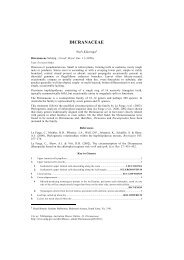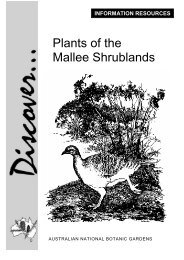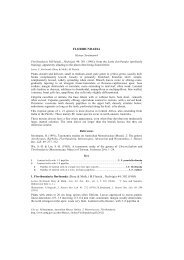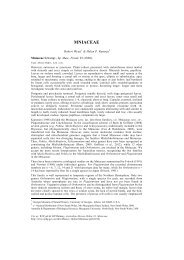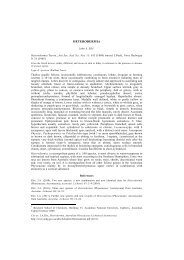Ptychostomum - Australian National Botanic Gardens
Ptychostomum - Australian National Botanic Gardens
Ptychostomum - Australian National Botanic Gardens
You also want an ePaper? Increase the reach of your titles
YUMPU automatically turns print PDFs into web optimized ePapers that Google loves.
middle and upper laminal cells rhomboidal to hexagonal, 40–70 × 10–15 µm (3–4: 1), thinwalled;<br />
several marginal rows of longer narrower more incrassate cells forming a distinct<br />
border; basal cells long-rectangular; cells in lower alar region of comal leaves inflated,<br />
reddish.<br />
Setae slender, 15–30 mm long. Capsules inclined to pendulous, symmetrical, narrowly<br />
pyriform, 2.5–3.5 mm long; operculum mammillose. Peristome well developed; exostome<br />
teeth narrowly lanceolate, brownish red; endostome segments with long perforations, c. as<br />
wide as long; basal membrane to c. half the height of the teeth; cilia 2, appendiculate. Spores<br />
14–16 µm diam. n = 30, fide H.P.Ramsay & J.R.Spence, J. Hattori Bot. Lab. 80: 260 (1996),<br />
as Bryum creberrimum.<br />
Widespread in W.A, S.A., N.S.W., A.C.T., Vic. and Tas.; uncommon on soil or in rock<br />
crevices, prefers sandy, basic substrata. A pantemperate species in both hemispheres.<br />
W.A.: Two Peoples Bay Nature Reserve, 30 km E of Albany, R.Wyatt & A.Stoneburner 3769 (PERTH).<br />
S.A.: Lees Springs, D.G.Catcheside 54.38 (AD). N.S.W.: trail above Blue L., Charlotte Pass, Kosciuszko<br />
Natl Park, J.R.Spence 4748 (NSW). A.C.T.: Brumby Flats, Brindabella Ra., L.Craven 545 (CANB).<br />
Vic.: Bogong High Plains, J.H.Willis s.n. (MEL). Tas.: Orford, 23 Sept. 1984, D.G.Catcheside (AD).<br />
<strong>Ptychostomum</strong> creberrimum can be distinguished by its synoicous perichaetia, elongate thinwalled<br />
laminal cells, leaf border and usually short-excurrent costa. This is very similar to the<br />
Northern Hemisphere species Bryum lisae De Not.<br />
4. <strong>Ptychostomum</strong> cylindrothecium (R.Br.ter.) J.R.Spence & H.P.Ramsay, Phytologia<br />
87: 63 (2005)<br />
Bryum cylindrothecium R.Br.ter., Trans. & Proc. New Zealand Inst. 31: 452 (1899).<br />
Zealand, Apr. 1882, R.Brown; holo: CHR.<br />
T: Waikari, New<br />
Dioicous. Plants in dense tufts to 15 mm tall, yellowish green above. Stems branched by a<br />
few perichaetial innovations, brownish-tomentose below. Leaves crowded in the upper part<br />
of the stem; lower leaves closely imbricate when dry, not much altered when moist, ovate or<br />
obovate with an acute apex and a non-decurrent base, to 1.5 mm long, strongly concave,<br />
innovation leaves smaller; margin plane or slightly reflexed in median to basal parts, entire;<br />
costa strong, long-excurrent with an arista, red towards the base; laminal cells thin-walled,<br />
hexagonal or rhomboidal-hexagonal, to 30–60 × 12–18 µm (3–4: 1); basal cells rectangular,<br />
indistinctly bordered by 1 or 2 rows of thin-walled more elongate cells; alar region of<br />
slightly inflated pinkish cells.<br />
Setae slender, erect, to 15–20 mm long. Capsules nutant to subpendulous, oblong-pyriform,<br />
3.0–3.5 mm long, pale brown; operculum convex, slightly apiculate. Peristome well<br />
developed; exostome teeth pale brown; endostome segments perforate; basal membrane high ,<br />
half the length of the exostome; cilia 2 or 3, appendiculate. Spores 10–12 µm diam.<br />
Chromosome number not known.<br />
Occurs on sandy soil in southern S.A.; also in New Zealand. Reported here for the first time<br />
from Australia.<br />
S.A.: Kangaroo Is., 28 Aug. 1948, H.B.S.Womersley (AD); Coorong, opposite Campbell Pt, V.Levitzke 968 (AD).<br />
<strong>Ptychostomum</strong> cylindrothecium can be separated from P. angustifolium by its distinctive leaf<br />
shape and broader laminal cells.<br />
5. <strong>Ptychostomum</strong> pseudotriquetrum (Hedw.) J.R.Spence & H.P.Ramsay, in J.R.Spence,<br />
Phytologia 87: 23 (2005)<br />
Mnium pseudotriquetrum Hedw., Sp. Musc. Frond. 190 (1801); Bryum pseudotriquetrum (Hedw.) Schwägr.,<br />
Sp. Musc., Suppl. 1, 2: 110 (1816). T: Europe; n.v.<br />
Bryum ventricosum Dicks. ex Relh., Fl. Cantab. 2nd edn, 427 (1802), nom. illeg.<br />
Bryum tasmanicum Hampe, Linnaea 25: 714 (1853).<br />
MEL.<br />
T: Europe; n.v.<br />
T: Van Diemensland, [Tas.], 1850, Stuart; holo: BM; iso:<br />
4





